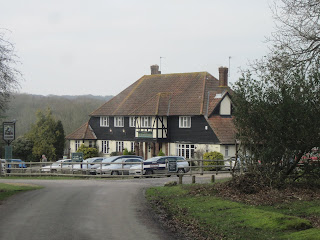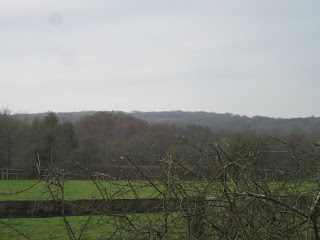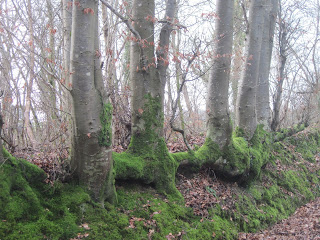
After a night of rain, the Forest was wet underfoot and grey clouds dimmed the afternoon light. We drove to Rufus Stone and looked across the road to the infamous site of a long ago death, where an old inscribed stone marks the untimely end of a Norman King.
William Rufus, King William II, was born in 1056 and was the second surviving son of King William I ( William the Conqueror) and Queen Matilda of Flanders. On the death of his father in 1087, William Rufus succeeded to the English throne while his brother, Robert, became king of the Duchy of Normandy in northern France.
William Rufus was not a popular king. He antagonised the Church and was seen as a ruthless king who lived for his own pleasure. His nickname, Rufus, may refer to his ruddy complexion and also to his notoriously fiery temper.
The Norman kings loved hunting above all other sports. William the Conqueror designated the New Forest as a Royal Hunting Forest and it remains as Crown Land today.
When Rufus was found dying by peasants in the New Forest, with an arrow puncturing his lung, it was said that his fellow huntman, Sir Walter Tyrrell ( Tirel), had mistakenly shot him while attempting to bring down a deer. However, some argue that this was a planned assassination, as William`s brother Henry was so quick to leave the hunting grounds of the Forest and return to Westminster, where he was duly crowned King of England. Sir Walter Tyrrell fled on horseback to the Hampshire coast, where he escaped to Normany and a life in exile.
There is a legend that the arrow hit an oak tree and was deflected towards the King, killing him by accident. This is the story told on the Rufus Stone monument which is said to mark the spot where William Rufus died.
All around the Rufus Stone there are young oak trees growing. Trees just a few hundred years old and younger. Trees that may be the grandchildren of the original oak that grew where William Rufus died.
All around the green and in the woods around it , oak trees were growing. Oaks in all stages of life, from youthful saplings to gnarled and sometimes tumour covered ancient trees. Their bare winter shapes brooded in the still air, against a grey sky.
Wild honeysuckle leaves had broken bud, in a tangle of vines that tumbled about the understory of the wood.
A young New Forest pony grazed on her own, finding new spring grass in the clearings beside the lane.
The Forest was so wet underfoot that we decided to walk along the quiet lane, instead of venturing down through the clay-boggy woods towards the stream.
Just around a corner was the Sir Walter Tyrrell, a Forest pub where travellers and walkers can stop for a drink or a meal. Behind the pub is an exciting wooden climbing playground for children, and a field where friendly donkeys live.
The inn sign shows William Rufus with his chest pierced by the arrow that killed him.
On the water sodden Forest green opposite, two young boys were leaping the puddles and splashing through the draining streams.
Up along the lane we walked, and found a shallow pond beside the road, beneath a hedge. Something in the water caught the light in a different way........
Masses of clear, round-jellied blobs of frogspawn clustered together amongst the water weed.
Each egg held a little black comma of new life. The first frogspawn we had seen this spring. We hoped for mild weather to help this mass of vulnerable lives along their way . Such an exciting thing to see!
A red bricked commoner`s cottage by the lane. It only leans because my camera slipped....
Further along, was the Manor Farm at Canterton.
Enclosed farmland has existed here as a pocket of green grazing for centuries, but is surrounded by wild Forest on every side.
Old lichen on an even older tree.
The lovely old Keepers Cottage on a corner of the lane....
....and down the hill we walked, to cross the Ford traversing a rushing stream called King`s Garn Gutter.
Reflected trees in water.......
...and a line of old, moss-covered hedgerow trees; their shapes showing how they were coppiced and laid in years gone by.
In a copse beside the lane, forestry work had taken place, with felling and clearing, piling and timber stacking. This conifer had a long life, each year a ring in its sharply sliced main trunk.
Down on the timber pile were lengths of oak, beech, conifer and silver birch.
Out of the wood and up between high hedges we walked. Someone was watching us.
Around the corner, up the hill and looking back to Skers Farm in the valley.
We had reached the outer edges of Brook, a hamlet mostly built along a main New Forest road.
There on the hill was one of the soggiest , muddiest golf courses I have ever seen!
We wondered how many golf balls were hidden in this poached, cattle trodden green and turned downhill towards the lane again. This was where I put my camera away and we strode out along the lane once more, through fields and the wooded valley, back to find the car, not far from the Rufus Stone.
















































11 comments:
You live in a really beautiful area and also full of history. I knew the story of William Rufus but didn't know that there was a stone marking the spot where he died. I've noticed the young honeysuckle leaves in my local woods too along with the bluebells pushing through the earth. A sign of things to come:)
Fascinating walk and history. Brought back many memories of similar walks long ago. "There'll always be an England!"
Thanks for dropping by my blog. No, I don't still have the ladies head. My Father was a painter and his friend was a master plasterer, they used to make them between them to sell. He would be amazed if he came back and new that simple things like that were now highly collectable.
I love the pictures of the trees, I simply love trees. Here in Brighton we are the last stronghold of the Elm tree and are doing everything possible to keep hold of them. The dutch elm disease has wiped out most of them and I notice sadly that one has had to be felled near the Brighton Pavilion. They are such majestic trees when full grown.
Briony
x
Gorgeous countryside. How dreamy the moss-covered hedgerow trees look and a smile to the curious pony :)
Beautiful photos as ever. I just forget how beautiful the Forest is. I have learned a lot today, I had not heard of Rufus Stone (he sounds like a soul singer LOL). I particularly liked the photos of the ford and the stream.
Some places I know (Rufus Stone of course and Brook), and others I've not been to - I certainly haven't done the walk you did, but what a nice one.
One of my mum's sisters thought she had really "arrived" when she and her husband got membership at Bramshaw Golf Club!
Rufus was my dad's father's given name. At least William Rufus got a better deal on a "disambiguator" than his dad did. I love how gnarled-y the oak branches are. Is this a characteristic of that kind of oak? Love the pix of the horse peering over the hedge. A lovely walk. Thanks for taking us along.
As ever, a lovely walk, and one which I wish I had been on in real life! But your post will do nicely as an alternative. Looked cold though!
Thank you for leaving a comment so that I can now explore your wonderful blog. I adore the New Forest and your pictures are fantastic.
Best wishes
Yarrow.x
ps, I didn't know the story behind Rufus Stone, so thank you :D
We pass the sign for Rufus stone on our way to Devon.Interesting history behind it.I remember seeing an oak tree in the forest that is reputed to be the oldest in the country,but I can't recall where exactly.Love your photos as always. :0)
WOL - Yes, oak trees do tend to get very gnarled and "arthritic" looking as they reach a great age.
Yarrow - Hello and welcome. I did enjoy your blog when I visited.
Bellaboo - Reputedly, the oldest tree in the New Forest is the Knightwood Oak. I shall have to drive over and take it`s photograph!
Post a Comment